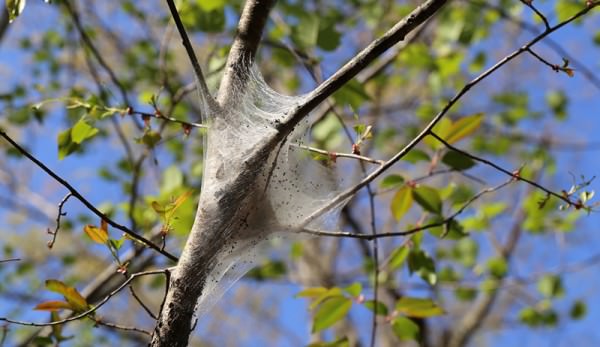
The eastern tent caterpillar (Malacosoma americanum) is common sight in landscapes and forests during spring and early summer with their trademark white tents found in the crooks of certain trees. A native North American pest, it’s (not surprisingly) found in the eastern half of the United States all the way to the Rocky Mountains and north into southern portions of Canada.
An avid leaf feeder, this caterpillar can be a bothersome pest that can completely defoliate its favored host trees, including native and domesticated varieties of apple, cherry, peach, pear, hawthorn and crabapples, when infestations are severe. When their preferred food sources become depleted, the caterpillars will often shift their focus to other native hardwoods in their range.
In the spring, the eggs of the eastern tent caterpillar will hatch and begin feeding on foliage. They will quickly begin creating a white tent or nest made of silk-like material that will shelter the caterpillars from predators and the elements. These tents are built in their host trees, allowing them to feed and find shelter all in the same place. The placement of these tents in the crotches of tree branches helps distinguish them from fall webworms or bagworms, two caterpillar species they’re commonly confused with.
Eastern tent caterpillars will reach between 2 and 2½ inches in length when fully grown. Their long body is hairy and typically tan-colored, with a white stripe running down the center of the back and a row of bright-blue oval shaped spots on each side of the body. After growing to their full size, the caterpillars will soon leave the nest and spin a cocoon. In three or four weeks, a red-brown adult moth will emerge from the cocoon and quickly seek a mate to begin the cycle again.
Feedings by these pest caterpillars can nearly defoliate host trees if a dense population is present. If trees are healthy, they’ll often survive this damage and push out new leaves. But trees that may already be stressed from disease or other environmental issues, like drought, can be destroyed by such a defoliation event. This is especially true of newly planted fruit trees in your landscape or orchard.
The best organic control where feasible is to eradicate the tent and the larva by hand or by using a long stick to wind up the silk and capture the caterpillars within. Attempt physical removal efforts in the early morning or evening when most of the caterpillars are still sheltering in the tent. There are also effective organic sprays that will help control caterpillar feeding on your orchard or landscape trees. The best sprays contain the active organic ingredient spinosad, which is sprayed directly onto the foliage of host plants.




